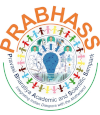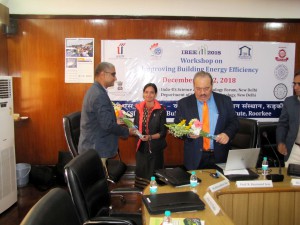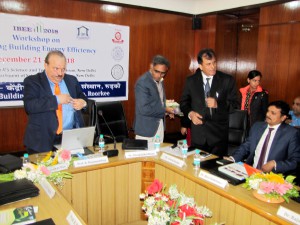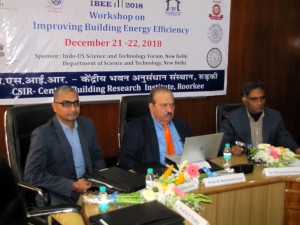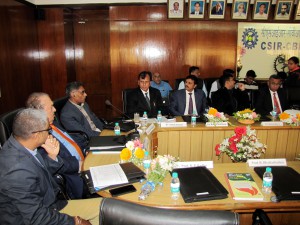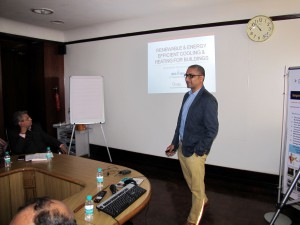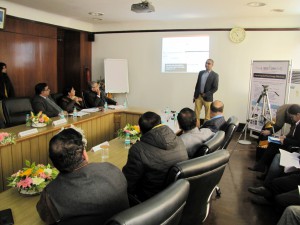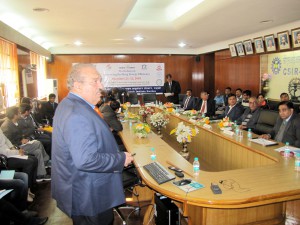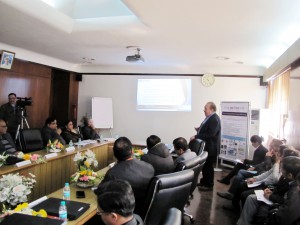December 21-22, 2018
The Workshop was organized by CSIR-CBRI, at Roorkee, as part of the Indo-US Project on “Improving Building Energy Efficiency”. The workshop started with the Opening Remarks given by Dr. N. Gopalakrishnan, Director, CSIR-CBRI, wherein he emphasized on the severe discomfort problems being faced by the people living in different parts of the country, particularly in the hot-dry and warm – humid climatic zones. He also mentioned on the R&D efforts made by the Institute in this regard and stressed on finding appropriate solutions both active and passive as well as renewable energy based solutions to address the large demand of electricity on one hand and also findings ways to minimize the wastages on the other hand.
Sh. Madhusudhan Rapole, Managing Director, Oorja Engineering, Hyderabad, graced the occasion as the Guest of Honour. He gave presentation on ‘Renewable & Energy Efficient Cooling & Heating of Buildings’. He also shared a few important projects being handled by his industry. Mr. Madhusudhan later agreed to work together and collaborate on two R&D areas with CSIR-CBRI: (i) Development of high efficiency solar collector; and (ii) Development of solid / liquid sorption cooling system.
Prof. R. Raymond Issa, Professor and Director of Rinker School of Construction Management at the University of Florida graced the occasion as Chief Guest and gave a talk on ‘Infrastructure Resiliency in Florida after 2017 Hurricanes’, in which he emphasized on the urgent need of resilient infrastructure in the sprawling suburban and petro-industrial landscape around Houston and along crowded coasts of Florida, in the face of increasing numbers of natural disasters fuelled by human-driven climate changes. He also talked about similar disasters in India and immediate need to find solutions and retrofitting the infrastructure to take care of any future eventualities along with climate change issues.
Dr. Ashok Kumar, Chief Scientist and Head, Architecture & Planning and Efficiency of Building, and the Principal Investigator of the Project and the Convener of the Workshop, gave an overview of the Indo-US Project on “Improving Building Energy Efficiency”. He also briefed the experts and members present about the significant progress made in the project and the importance of the workshop in terms of Research – Academia – Industry interface. Dr. Ashok urged the industry experts to collaborate with CSIR-CBRI in taking the fruits of research as products, to field / industry and become incubators. On this, the industry experts showed their interest on joint collaboration and networking R&D with CSIR-CBRI.
 Prof. N.P. Padhy, Professor and Dean, IIT Roorkee, delivered a Keynote on Microgrids wherein he emphasized on the importance of designing buildings having two different systems in buildings for electrical AC and DC loads like; (i) AC, fridge, lighting, washing machines, dishwasher, microwave, etc. and (ii) others for laptop, computers, mobile phone charging, etc. that do not require AC supply and may run on DC grids. He also highlighted the role of AC and DC grids in minimizing the energy loads in buildings.
Prof. N.P. Padhy, Professor and Dean, IIT Roorkee, delivered a Keynote on Microgrids wherein he emphasized on the importance of designing buildings having two different systems in buildings for electrical AC and DC loads like; (i) AC, fridge, lighting, washing machines, dishwasher, microwave, etc. and (ii) others for laptop, computers, mobile phone charging, etc. that do not require AC supply and may run on DC grids. He also highlighted the role of AC and DC grids in minimizing the energy loads in buildings.
 Mr. Ashish Bahal, a Senior Faculty in Philips Lighting Academy and Head – Architect Program & Creative Design, gave a talk on green design and aesthetic approach to Lighting Design, and in Interiors. He demonstrated lighting technologies for interiors, habitat, and architecture. He also emphasized on importance of balanced approach to lighting design for better energy efficiency and issues like over light / glare and cool lights for different typology of buildings and the science behind in creating lighting interiors for comfortable environments.
Mr. Ashish Bahal, a Senior Faculty in Philips Lighting Academy and Head – Architect Program & Creative Design, gave a talk on green design and aesthetic approach to Lighting Design, and in Interiors. He demonstrated lighting technologies for interiors, habitat, and architecture. He also emphasized on importance of balanced approach to lighting design for better energy efficiency and issues like over light / glare and cool lights for different typology of buildings and the science behind in creating lighting interiors for comfortable environments.
 Dr. Bishwajit Bhattacharjee, Professor, IIT Delhi gave a talk on ‘Daylight, Its Analysis, and Lighting for Improving Building Energy Efficiency – Present Trends and the Future Directions’, where the basic concepts of daylighting were explained in terms of three components of Sky component, ERC and SRC. The principle of estimation, followed by existing Indian standard design sky and related design principle, relevant researches since the CBRI-proposed Indian design sky and discussions on Kitlers, CIE, Perez model etc., with future scope of research in Indian context of fenestration design for daylighting and its implications on energy efficiency were elaborated by him.
Dr. Bishwajit Bhattacharjee, Professor, IIT Delhi gave a talk on ‘Daylight, Its Analysis, and Lighting for Improving Building Energy Efficiency – Present Trends and the Future Directions’, where the basic concepts of daylighting were explained in terms of three components of Sky component, ERC and SRC. The principle of estimation, followed by existing Indian standard design sky and related design principle, relevant researches since the CBRI-proposed Indian design sky and discussions on Kitlers, CIE, Perez model etc., with future scope of research in Indian context of fenestration design for daylighting and its implications on energy efficiency were elaborated by him.
 Mr. Udeet J. Banker, Director, Rivashaa Eco Design Solutions, Ahemedabad made presentation on ‘Geotechnical Application and Structural Lightweight Concrete using Expanded Clay Aggregate (ECA)’, the suitability of ECA concrete, as lightweight, green and construction material and its benefits, including cost savings, design flexibility, and proven performance when used in sustainable construction and green buildings. He also emphasized on reducing carbon emissions through ECA and to promote a sustainable ecosystem in the future.
Mr. Udeet J. Banker, Director, Rivashaa Eco Design Solutions, Ahemedabad made presentation on ‘Geotechnical Application and Structural Lightweight Concrete using Expanded Clay Aggregate (ECA)’, the suitability of ECA concrete, as lightweight, green and construction material and its benefits, including cost savings, design flexibility, and proven performance when used in sustainable construction and green buildings. He also emphasized on reducing carbon emissions through ECA and to promote a sustainable ecosystem in the future.
Dr. Ravi Srinivasan, Associate Professor of Low / Net Zero Energy Buildings at the M.E. Rinker, Sr. School of Construction Management, University of Florida as well as an External Faculty Collaborator, Center for Environmental & Building Design, University of Pennsylvania, gave a talk on ‘Micro- and Macro-scale Modeling, Simulation, and Visualization of Buildings and Cities’, in which he discussed some of his research projects with a particular focus on micro- (e.g., building envelope component) and macro-scale (e.g., urban energy models) modeling, simulation, and visualization.
Dr. Ravi also explored the possibility of joint R&D collaboration and networking with CSIR-CBRI on Modeling, Simulation, and Visualization of Buildings and Cities as part of the Smart City Mission of Government of India, in general and improving building energy efficiency in particular by identifying a city where CSIR-CBRI and University of Florida may work together in developing innovative smart solutions.
Mr. Ajay Singh, Sr. General Manager, Lloyd Insulations (India) Limited, gave a talk on ‘Thermal insulation for improving building energy efficiency’. Mr. Singh gave an overview of the types of insulating materials being produced in India and its scope in the future. He also showed some of the case studies where the insulation has been used externally in reducing energy consumption. Later on, he extended support and joint R&D on thermal insulation in building industry looking into the changes taking place in ECBC and NBC 2016.
 Mr. Rajeev Goswami, Manufacturing Head, AIS Glass Solutions Ltd. gave a talk on ‘Smart Glass and Glass for Solar Applications’. Mr. Rajeev discussed the types of glass being manufactured by ASAHI, particularly the solar control and smart glass, Swytchglas etc. He also extended support and joint collaboration & networking R&D on glass to be used in developing the solar collector by CSIR-CBRI.
Mr. Rajeev Goswami, Manufacturing Head, AIS Glass Solutions Ltd. gave a talk on ‘Smart Glass and Glass for Solar Applications’. Mr. Rajeev discussed the types of glass being manufactured by ASAHI, particularly the solar control and smart glass, Swytchglas etc. He also extended support and joint collaboration & networking R&D on glass to be used in developing the solar collector by CSIR-CBRI.
Similarly, the presentations were made by the following CSIR-CBRI scientists: (i) Dr. Rajni Lakhani & Sh. Rajesh Kumar, on ‘Developing cost effective and durable masonry blocks having high thermal insulation properties using industrial / agro industrial waste’; (ii) Dr. L.P.Singh & Sh. Srinivasrao Naik, ‘Phase Change materials for energy efficiency’, (iii) Mr. Nagesh Balam, Dr. Tabish Alam, & Mr. Chandan Swaroop, ‘Modular Thermally Activated Solar Desiccant Based Cooling System’, (iv) Dr. Ashok Kumar, Dr. Anuj Kumar, & Mr. Kshitij Jain, ‘App for Integrating Daylight with Artificial Lighting for Improving Building Energy Efficiency during daytime in Indian climates and LED drivers’, (v) Dr. Kishor Kulkarni & Ms. Sayantani Lala, ‘Climate Classification’, (v) Dr. S.K.Medda & Mr. Srikrishana Manna, CSIR-CGCRI, Kolkata, ‘Transparent coatings on glass and antireflective – cum – self cleaning coatings on solar glasses (by sol-gel processing on plastics, glasses and metals)’, and (vi) Dr. E.Rajasekar, IIT Roorkee, ‘Climatic data, revised map, and thermal performance of buildings’. The experts shared the work being done under different tasks of the project and how industry can join hands in taking the fruits of research to next levels with a view to take them to society.
Dr. Ashok Kumar




